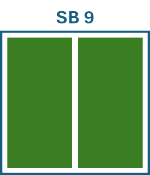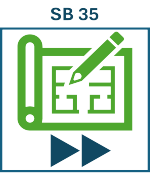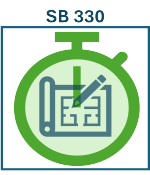
Housing Laws in Action
Overview
Over the last decade, the State of California Legislature has responded to the housing crisis by passing legislation to make it easier to build more housing. The County of San Diego has compiled information on recent housing legislation applicable to the unincorporated area.
This page provides resources, maps, and checklists to understand how new state housing laws apply in San Diego County. Each of these laws were passed to provide clear guidelines and improve the process for developing housing. The State Legislature continues to pass new bills each year and this page will be updated periodically to reflect new laws as they are enacted.
The County of San Diego complies with all state housing and land use bills as soon as they take effect.

Housing and Land Use Laws
Single Family Lot Splits (SB 9)
SB 9 (2021) allows development of up to 4 housing units on lots in certain single-family residential zones by allowing residential lots to split and build two units, one main housing unit and one Accessory Dwelling Unit (ADU).
See if your property qualifies for SB 9 on the Interactive
SB 9 Map
Learn more about qualifying for SB 9 on the SB 9 Application User Guide
For more details on SB 9, visit the SB 9 Homepage

Starter Homes on Multifamily Lots (SB 684)
SB 684 (2023) allows certain projects to subdivide up to 10 lots to develop up to 10 housing units. Lot sizes can be subdivided down to 600 square feet.
See properties that may qualify on the Interactive SB 684 Map
Learn more about qualifying for SB 684 on the SB 684 Application Guide
SB 1123, which expands the eligibility of SB 684, went into effect July 1, 2025. Updated materials that reflect these changes will be available soon. See SB 1123 for more information.

Starter Home Revitalization Act (AB 803)
AB 803 (2021), or the Starter Home Revitalization Act of 2021, allows the subdivision of multifamily lots up to the density of the General Plan Land Use Designation. For example, a qualifying one acre property that allows 20 dwelling units per acre may be allowed to subdivide to 20 lots with one home on each lot.
See properties that may qualify on the Interactive AB 803 Map
Learn more about qualifying for AB 803 on the AB 803 Application Guide
See the General Plan densities in your community on the San Diego County General Plan and Zoning Map

Housing in Commercial Zones (SB 6)
SB 6 (2022), or the Middle Class Housing Act of 2022, allows housing in zones where retail, office, or parking are permitted uses. SB 6 creates both a ministerial and discretionary approval process for housing projects in these zones and allows densities up to 30 dwelling units per acre. The ministerial process requires some affordable housing and skilled labor requirements.
See properties that may qualify on the Interactive SB 6 Map
Learn more about qualifying for SB 6 on the SB 6 Application Guide
For more details on SB 6, visit the AB 2011 and SB 6 Homepage

Housing Along Large Commercial Streets (AB 2011)
AB 2011 (2022), or The Affordable Housing and High Road Jobs
Act of 2022, allows 100% affordable housing developments in commercial
zones and mixed income housing projects along large commercial
streets. Allowed densities vary, but start at 30 dwelling units per
acre and go higher for projects on large lots along commercial
corridors. All mixed-use housing projects approved using AB 2011 are
under the ministerial process and required to include affordable
housing and pay prevailing wages.
See properties that may qualify on the Interactive AB 2011 Map
Learn more about qualifying for AB 2011 on the AB 2011 Application Guide for Affordable Housing and the AB 2011 Appplication Guide for Mixed-Income Housing
For more details on AB 2011, visit the AB 2011 and SB 6 Homepage

Faster Approval for Multifamily Developments (SB 35)
SB 35 (2017) creates a ministerial approval process for qualifying multifamily housing projects. These projects must include some affordable housing and pay prevailing wages as they are built.
See properties that may qualify on the Interactive SB 35 Map
Learn more about qualifying for SB 35 on the SB 35 Application User Guide

By-Right Approval for RHNA Sites (AB 1397)
AB 1397 (2017) is a state law that requires jurisdictions to implement a by-right approval process for housing developments on relisted sites. Eligible sites have been relisted from the previous 4th and 5th Cycle Housing Elements and are included in the County's 6th Cycle Housing Element Regional Housing Needs Assessment (RHNA) Site Inventory.
See properties that may qualify on the Eligibility Spreadsheet
Learn more about qualifying for AB 1397 on the AB 1397 Application Guide
For more details on AB 1397, visit the AB 1397 Home page

Preliminary Applications for Multi-unit Projects (SB 330)
The SB 330 (2019) preliminary application allows housing development projects to lock in ordinances, policies, and fees for their project up to 180 days prior to submitting a completed full application.
Eligible project types include:
- Housing Projects of two or more housing units
- Mixed-use Projects where two thirds of floor space is designated for residential use
- Transitional, Supportive, or Emergency Housing
- Farmworker Housing

California Environmental Quality Act (CEQA) Exemption for Infill Housing (AB 130)
AB 130 (2025) creates a CEQA exemption for qualifying housing developments with densities of 15 dwelling units per acre or more.
See properties that may qualify on the Interactive AB 130 Webmap
Learn more about qualifying for AB 130 on the AB 130 Application Guide
Density Bonus Program
The California State Density Bonus Law encourages the development of affordable housing by providing developers with incentives and concessions related to zoning development standards. The San Diego County Density Bonus Ordinance further promotes this program by offering additional incentives.
Learn more about State Density Bonus Law: State Density Bonus Law
Learn more about the County’s Density Bonus Program: Density Bonus FAQs
Objective Design Standards
Objective design standards (ODS) strengthen local control over the design and appearance of future housing developments in applicable areas of the unincorporated county. By making design standards more predictable and easier to understand, the County will also streamline the permitting process for eligible projects to comply with new State laws.
Objective Design Standards were mandated by state law and are applicable for projects using SB 35, SB 330, AB 2011, SB 6, and other projects. According to state law, Objective Design Standards:
- Involve no personal or subjective judgment
- Are uniformly verifiable by an established and known benchmark
The objective checklists below have been created to provide measurable, verifiable, and clear objective design standards. The standards are based on Community Plan policies and Design Guidelines, as well as relevant policies from the General Plan and other adopted documents:
- Alpine (outside of Form Based Code areas)
- Bonsall
- Lakeside
- Ramona (outside of Form Based Code areas)
- Spring Valley
- Sweetwater
- Valley Center
Contact
If you have any questions, please email us at PDSZoningPermitCounter@sdcounty.ca.gov.








